-
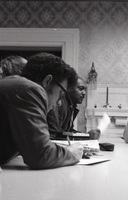 Detective John Garland
Detective John Garland A photograph of Detective John Garland, taken during the People's Lounge arrests.
-
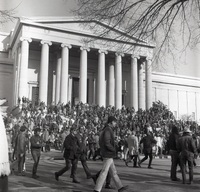 Scenes from the 1969 March on D.C., 4
Scenes from the 1969 March on D.C., 4 A photograph depicting scenes from the 1969 March on D.C.
-
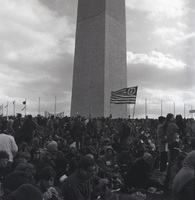 Scenes from the 1969 March on D.C., 3
Scenes from the 1969 March on D.C., 3 A photograph depicting scenes from the 1969 March on D.C.
-
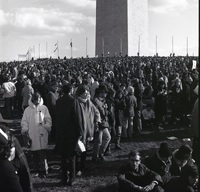 Scenes from the 1969 March on D.C., 2
Scenes from the 1969 March on D.C., 2 A photograph depicting scenes from the 1969 March on D.C.
-
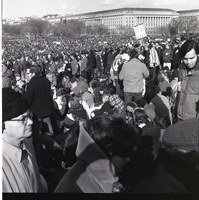 Scenes from the 1969 March on D.C., 1
Scenes from the 1969 March on D.C., 1 A photograph depicting scenes from the 1969 March on D.C.
-
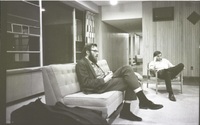 Richard Sroges
Richard Sroges A photograph of former faculty member, Richard Sroges.
-
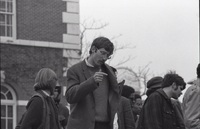 Tom Heisler
Tom Heisler A photograph of former English department faculty member, Tom Heisler, at a student rally.
-
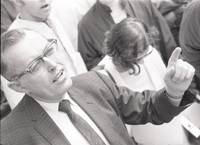 Robert Zumwinkle
Robert Zumwinkle A photograph of former administrator, Robert Zumwinkle.
-
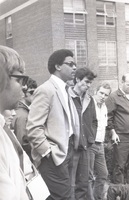 Ken Moon
Ken Moon A photograph of former administrator, Ken Moon, at a student rally.
-
 President Harold Sponberg
President Harold Sponberg A photograph of former University President, Harold Sponberg.
-
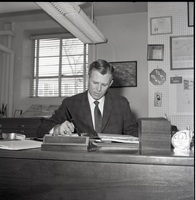 Lewis Profit at His Desk
Lewis Profit at His Desk A photograph of former administrator Lewis Profit at his desk.
-
 Students in Front of President Sponberg's Home
Students in Front of President Sponberg's Home Photograph of students in front of President Sponberg's home.
-
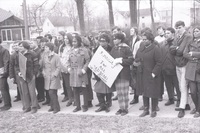 "Amnesty for All!"
"Amnesty for All!" Photograph of a poster at the BSA rally.
-
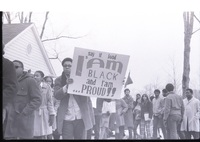 "Say it Loud, I am Black and I am Proud!"
"Say it Loud, I am Black and I am Proud!" Photograph of a poster at the BSA rally.
-
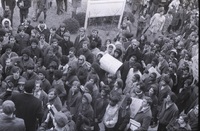 BSA Marchers, 2
BSA Marchers, 2 Photograph of BSA marchers
-
 Students Marching on Starkweather, Forest Ave.
Students Marching on Starkweather, Forest Ave. Photograph of BSA marchers in front of Starkweather Hall, on old Forest Ave.
-
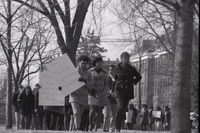 BSA Marchers with more Signs
BSA Marchers with more Signs Photograph of students marching at the BSA rally.
-
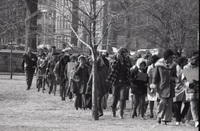 BSA Marchers
BSA Marchers Photograph of students marching at the BSA rally.
-
 BSA Marchers with their "Amnesty" signs
BSA Marchers with their "Amnesty" signs Photograph of students with handmade posters at the BSA rally.
-
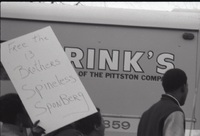 "Free the 13 Brothers," Protest Sign
"Free the 13 Brothers," Protest Sign Photograph of a poster at the BSA rally.
-
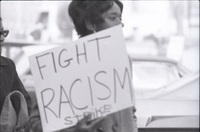 "Fight Racism," Protest Sign
"Fight Racism," Protest Sign Photograph of a poster at the BSA rally.
-
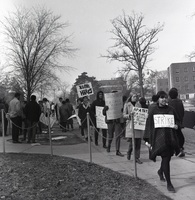 BSA Rally Marchers with their Signs
BSA Rally Marchers with their Signs Photograph of a poster at the BSA rally.
-
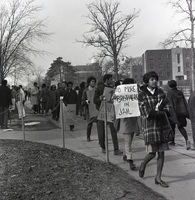 BSA Rally Sign, "No More Brothers in Jail"
BSA Rally Sign, "No More Brothers in Jail" Photograph of a poster at the BSA rally.
-
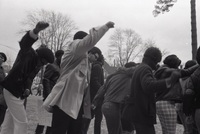 Students Raise Their Fists, BSA Rally
Students Raise Their Fists, BSA Rally A photograph of students raising their fists in solidarity during the BSA march.
-
 Students Gathered in Front of President Sponberg's Home
Students Gathered in Front of President Sponberg's Home A photograph of students rallying in front of the University President's house during the BSA takeover.
-
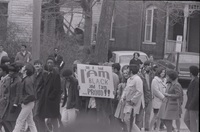 "I am Black and I am Proud," Poster
"I am Black and I am Proud," Poster Photograph of a poster at the BSA rally
-
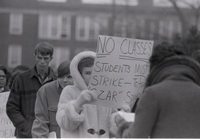 Poster at the BSA Rally
Poster at the BSA Rally Photograph of a poster at the BSA rally
-
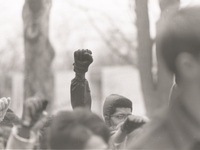 Floyd Walton Raises a Fist
Floyd Walton Raises a Fist A photograph of EMU student and BSA member Floyd Walton raises his fist in solidarity during the BSA takeover of Pierce Hall.
-
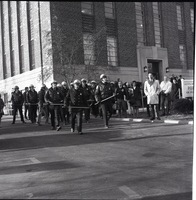 Police On Their Way to Pierce Hall
Police On Their Way to Pierce Hall A photograph depicting police officers on their way to Pierce Hall during the BSA takeover of 1969.
-
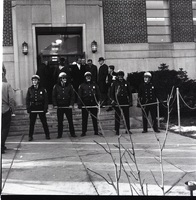 Police Guarding Pierce Hall
Police Guarding Pierce Hall A photograph depicting police officers guarding the front doors of Pierce Hall during the BSA takeover of 1969.
-
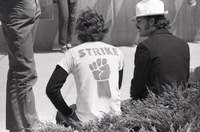 "Strike!" Shirt, 1970
"Strike!" Shirt, 1970 A photograph depicting a student in April of 1970 wearing a handmade strike shirt.
-
 Terry Auten, Oral History Interview, 2022
Terry Auten, Oral History Interview, 2022 In the Fall of 2022, Matt Jones’s Oral History Techniques class conducted a set of interviews documenting the stories behind the student unrest on Eastern Michigan University’s campus from 1966-1972. Terry Auten was a student at EMU during the late 1960s and early 1970s who travelled to the National Student Conference on Vietnam, held at Cornell University and brought back to EMU his perspective on the War and increased student activism on campus.
-
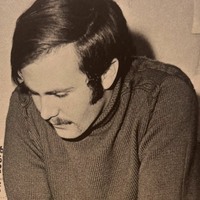 Rob Musial, Oral History Interview, 2022
Rob Musial, Oral History Interview, 2022 In the Fall of 2022, Matt Jones’s Oral History Techniques class conducted a set of interviews documenting the stories behind the student unrest on Eastern Michigan University’s campus from 1966-1972. Rob Musial was a student at EMU during the late 1960s and early 1970s, and editor of the Eastern Echo during that time. Rob was involved with reporting on campus demonstrations and student unrest during his time there, working to make the campus aware of what was going on.
-
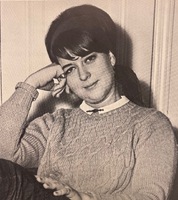 Pat Fry, Oral History Interview, 2022
Pat Fry, Oral History Interview, 2022 In the Fall of 2022, Matt Jones’s Oral History Techniques class conducted a set of interviews documenting the stories behind the student unrest on Eastern Michigan University’s campus from 1966-1972. Pat Fry was an EMU student in the late 1960s and early 1970s. She was a member of the Student Liberation Action Movement, wrote for underground newspaper The Second Coming, and Communist activist. Pat dedicated her life to fighting for equality and justice for all, continuing to be an advocate until she passed away in 2023.
-
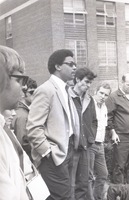 Ken Moon, Oral History Interview, 2022
Ken Moon, Oral History Interview, 2022 In the Fall of 2022, Matt Jones’s Oral History Techniques class conducted a set of interviews documenting the stories behind the student unrest on Eastern Michigan University’s campus from 1966-1972. Ken Moon was a Black administrator at EMU during the lates 1960s and early 1970s, and an important mediator between the students and the administration. Moon was an influential figure on campus and supported students academically and personally.
-
 John Enlund, Oral History Interview, 2022
John Enlund, Oral History Interview, 2022 In the Fall of 2022, Matt Jones’s Oral History Techniques class conducted a set of interviews documenting the stories behind the student unrest on Eastern Michigan University’s campus from 1966-1972. John Enlund was a dedicated student activist on EMU's campus, member of Students for a Democratic Society, and one of the students arrested at McKenny Hall on campus during the People's Lounge Incident. He was involved with others like Frank Michels and Barry Simon during this time of student unrest, and left his mark on EMU.
-
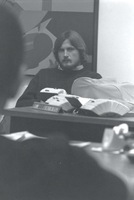 Jan Kaulins, Oral History Interview, 2022
Jan Kaulins, Oral History Interview, 2022 In the Fall of 2022, Matt Jones’s Oral History Techniques class conducted a set of interviews documenting the stories behind the student unrest on Eastern Michigan University’s campus from 1966-1972. Jan Kaulins was the supreme justice on the student court at EMU during the late 1960s and early 1970s. Jan was involved with the student unrest on campus, and ruled on important cases that were brought to the court, such as the Second Coming trials. He went on to graduate school at the University of Michigan after EMU.
-
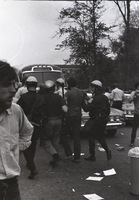 Greg Fournier, Oral History Interview, 2022
Greg Fournier, Oral History Interview, 2022 In the Fall of 2022, Matt Jones’s Oral History Techniques class conducted a set of interviews documenting the stories behind the student unrest on Eastern Michigan University’s campus from 1966-1972. Greg Fournier is a current author and EMU alum who was witness to the student unrest on campus, which was happening at the same time John Norman Collins was committing his crimes. Now, Greg has written about John in his book, "Terror in Ypsilanti."
-
 Gerald "Skip" Lawver, Oral History Interview, 2022
Gerald "Skip" Lawver, Oral History Interview, 2022 In the Fall of 2022, Matt Jones’s Oral History Techniques class conducted a set of interviews documenting the stories behind the student unrest on Eastern Michigan University’s campus from 1966-1972. Gerald "Skip" Lawver was an EMU student who served as an intelligence officer in the US Army, an instructor with the EMU Reserve Officers Training Corps (ROTC), a sergeant with the EMU police force. Skip was a sergeant with EMU during the events that took place near EMU's campus in May of 1970, working to keep things under control.
-
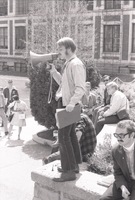 Frank Michels, Oral History Interview, 2022
Frank Michels, Oral History Interview, 2022 In the Fall of 2022, Matt Jones’s Oral History Techniques class conducted a set of interviews documenting the stories behind the student unrest on Eastern Michigan University’s campus from 1966-1972. Frank Michels was a student at EMU in the late 1960s and early 1970s. Frank was a student activist, a dedicated member of Students for a Democratic Society, and the creator of the underground newspaper, The Second Coming. He was a radical leader on campus who fought back against the administration's policies and their efforts to take his newspaper down.
-
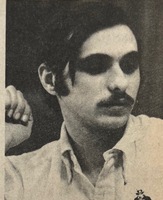 Ed Mattos, Oral History Interview, 2022
Ed Mattos, Oral History Interview, 2022 In the Fall of 2022, Matt Jones’s Oral History Techniques class conducted a set of interviews documenting the stories behind the student unrest on Eastern Michigan University’s campus from 1966-1972. Ed Mattos was a student at EMU in the late 1960s and early 1970s. He was a student activist, most notably as the chairman of the Student Mobilization Committee. Mattos dedicated his time at EMU to being an activist, and was involved with demonstrations on campus.
-
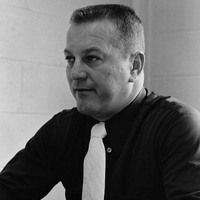 Doug Harvey, Oral History Interview, 2022
Doug Harvey, Oral History Interview, 2022 In the Fall of 2022, Matt Jones’s Oral History Techniques class conducted a set of interviews documenting the stories behind the student unrest on Eastern Michigan University’s campus from 1966-1972. Harvey served two consecutive terms as sheriff between 1964 and 1972, and during that time he was tasked with managing the protests on EMU's campus. He was a strong individual in the Ypsilanti community, a force to be reckoned with until he passed away in 2023.
-
 Dennis Hertel, Oral History Interview, 2022
Dennis Hertel, Oral History Interview, 2022 In the Fall of 2022, Matt Jones’s Oral History Techniques class conducted a set of interviews documenting the stories behind the student unrest on Eastern Michigan University’s campus from 1966-1972. Dennis Hertel was an EMU student in the late 1960s and early 1970s. Vice President of the student body, and president of the student senate, Hertel was involved in making important decisions regarding the status of student unrest and upset with EMU administration. He would go on to be a United States congressman.
-
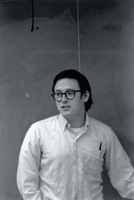 David Cahill, Oral History Interview, 2022
David Cahill, Oral History Interview, 2022 In the Fall of 2022, Matt Jones’s Oral History Techniques class conducted a set of interviews documenting the stories behind the student unrest on Eastern Michigan University’s campus from 1966-1972. A former political science assistant professor at Eastern Michigan from 1969 to 1970, David Cahill was "non-rehired" after just one year for his support of students and the underground newspaper, the Second Coming. His dismissal fueled student unrest and upset with EMU administration, which led to a student led strike.
-
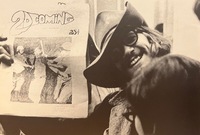 Dave Barsky, Oral History Interview, 2022
Dave Barsky, Oral History Interview, 2022 In the Fall of 2022, Matt Jones’s Oral History Techniques class conducted a set of interviews documenting the stories behind the student unrest on Eastern Michigan University’s campus from 1966-1972. Dave Barsky was a student at EMU in the late 1960s and early 1970s. He was a dedicated student activist, and worked closely with others like Frank Michels on the Second Coming. Barsky was represented by the American Civil Liberties Union after getting expelled from EMU, and continued to be an activist leader.
-
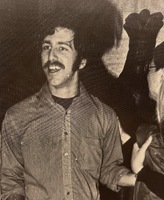 Barry Simon, Oral History Interview, 2022
Barry Simon, Oral History Interview, 2022 In the Fall of 2022, Matt Jones’s Oral History Techniques class conducted a set of interviews documenting the stories behind the student unrest on Eastern Michigan University’s campus from 1966-1972. Barry Simon was an EMU student in the late 1960s and early 1970s. He was a student activist involved in underground newspaper the Second Coming, and eventually arrested during the People's Lounge incident in McKenny Hall on EMU's campus. Simon would later become the student body president.
-
 Anthony Head, Oral History Interview, 2022
Anthony Head, Oral History Interview, 2022 In the Fall of 2022, Matt Jones’s Oral History Techniques class conducted a set of interviews documenting the stories behind the student unrest on Eastern Michigan University’s campus from 1966-1972. Anthony Head was a student at EMU during this time, and became involved with student activism and campus demonstrations after learning about counterculture and left-leaning politics.
-
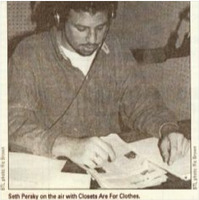 Closets R4 Clothes Radio Broadcast, December 11, 1990
Closets R4 Clothes Radio Broadcast, December 11, 1990 Closets R4 Clothes was a LGBTQ oriented student radio program from the University of Michigan's WCBN Ann Arbor. The Closets R4 Clothes collection in the Eastern Michigan University Archives contains radio broadcast recordings from 1988 to 1999. This December 1990 broadcast includes an interview with the Director Urvashi Vaid of the National Gay and Lesbian Task Force, musical selections, and a sketch comedy piece.
-
 Closets R4 Clothes Radio Broadcast, October 23, 1990
Closets R4 Clothes Radio Broadcast, October 23, 1990 Closets R4 Clothes was a LGBTQ oriented student radio program from the University of Michigan's WCBN Ann Arbor. The Closets R4 Clothes collection in the Eastern Michigan University Archives contains radio broadcast recordings from 1988 to 1999. This October 1990 broadcast includes musical selections, information on queer events in Ann Arbor and Washtenaw County, LGBTQ-related news from around the world, and an interview with American cartoonist and original creator of the Bechdel test, Alison Bechdel.
-
 Closets R4 Clothes Radio Broadcast, February 16, 1995
Closets R4 Clothes Radio Broadcast, February 16, 1995 Closets R4 Clothes was a LGBTQ oriented student radio program from the University of Michigan's WCBN Ann Arbor. The Closets R4 Clothes collection in the Eastern Michigan University Archives contains radio broadcast recordings from 1988 to 1999. This February 1995 broadcast includes an interview with famed poet and writer Allen Ginsberg.
-
 Closets R4 Clothes Radio Broadcast, August 20, 1991
Closets R4 Clothes Radio Broadcast, August 20, 1991 Closets R4 Clothes was a LGBTQ oriented student radio program from the University of Michigan's WCBN Ann Arbor. The Closets R4 Clothes collection in the Eastern Michigan University Archives contains radio broadcast recordings from 1988 to 1999. This August 1991 broadcast includes information about queer events in Ann Arbor and Washtenaw County, musical selections, LGBTQ-related news from around the world, and an interview with an Ann Arbor area lesbian male impersonator.
-
 Closets R4 Clothes Radio Broadcast, July 23, 1991
Closets R4 Clothes Radio Broadcast, July 23, 1991 Closets R4 Clothes was a LGBTQ oriented student radio program from the University of Michigan's WCBN Ann Arbor. The Closets R4 Clothes collection in the Eastern Michigan University Archives contains radio broadcast recordings from 1988 to 1999. This July 1991 broadcast includes musical selections, information on queer events in Ann Arbor and Washtenaw County, and LGBTQ news from around the world.
-
 Closets R4 Clothes Radio Broadcast, July 16, 1991
Closets R4 Clothes Radio Broadcast, July 16, 1991 Closets R4 Clothes was a LGBTQ oriented student radio program from the University of Michigan's WCBN Ann Arbor. The Closets R4 Clothes collection in the Eastern Michigan University Archives contains radio broadcast recordings from 1988 to 1999. This July 1991 broadcast includes a listing of local queer events in Ann Arbor and Washtenaw County, LGBTQ-related news from around the world, musical selections, and the second half of an interview with Native American and AIDS activist Beth Brant.
-
 Closets R4 Clothes Radio Broadcast July 07, 1991
Closets R4 Clothes Radio Broadcast July 07, 1991 Closets R4 Clothes was a LGBTQ oriented student radio program from the University of Michigan's WCBN Ann Arbor. The Closets R4 Clothes collection in the Eastern Michigan University Archives contains radio broadcast recordings from 1988 to 1999. This July 1991 broadcast includes information on queer related cinema, LGBTQ news from across the country, musical selections, and a piece by drag queen Vaginal Cream Davis.
-
 Closets R4 Clothes Radio Broadcast, June 04, 1991
Closets R4 Clothes Radio Broadcast, June 04, 1991 Closets R4 Clothes was a LGBTQ oriented student radio program from the University of Michigan's WCBN Ann Arbor. The Closets R4 Clothes collection in the Eastern Michigan University Archives contains radio broadcast recordings from 1988 to 1999. This June 1991 broadcast includes an intro to the twelfth anniversary of the White Night riots in San Francisco that occurred after the assassination of Harvey Milk, musical selections, and a reading of a poem titled "I am a SCAB (Society for the Complete Annihilation of Breeding)."
-
 Closets R4 Clothes Radio Broadcast, January 28, 1991
Closets R4 Clothes Radio Broadcast, January 28, 1991 Closets R4 Clothes was a LGBTQ oriented student radio program from the University of Michigan's WCBN Ann Arbor. The Closets R4 Clothes collection in the Eastern Michigan University Archives contains radio broadcast recordings from 1988 to 1999. This January 1991 includes an interview with Indigo Girls singer/songwriter Amy Ray.
-
 Closets R4 Clothes Radio Broadcast, January 22, 1991
Closets R4 Clothes Radio Broadcast, January 22, 1991 Closets R4 Clothes was a LGBTQ oriented student radio program from the University of Michigan's WCBN Ann Arbor. The Closets R4 Clothes collection in the Eastern Michigan University Archives contains radio broadcast recordings from 1988 to 1999. This January 1991 broadcast includes an interview with Elise Bryant, a Ann Arbor-based playwriter of the production of "Zoo Zoo Chronicles."
-
 Closets R4 Clothes Radio Broadcast, January 15, 1991
Closets R4 Clothes Radio Broadcast, January 15, 1991 Closets R4 Clothes was a LGBTQ oriented student radio program from the University of Michigan's WCBN Ann Arbor. The Closets R4 Clothes collection in the Eastern Michigan University Archives contains radio broadcast recordings from 1988 to 1999. This January 1991 broadcast includes an interview with Ilene Lynch from the domestic violence organization SafeHouse about the topic of lesbian battery.
-
 Closets R4 Clothes Radio Broadcasts, February 05, 1991
Closets R4 Clothes Radio Broadcasts, February 05, 1991 Closets R4 Clothes was a LGBTQ oriented student radio program from the University of Michigan's WCBN Ann Arbor. The Closets R4 Clothes collection in the Eastern Michigan University Archives contains radio broadcast recordings from 1988 to 1999. The February 1991 broadcast includes LGBTQ news and events in Washtenaw County as well as an interview with LGBTQ novelist Lev Raphael.
-
 Closets R4 Clothes Radio Broadcast, October 1990
Closets R4 Clothes Radio Broadcast, October 1990 Closets R4 Clothes was a LGBTQ oriented student radio program from the University of Michigan's WCBN Ann Arbor. The Closets R4 Clothes collection in the Eastern Michigan University Archives contains radio broadcast recordings from 1988 to 1999. This October 1990 broadcast includes an interview with novelist and gay activist Sarah Schulman.
-
 Closets R4 Clothes Radio Broadcast, September 1990
Closets R4 Clothes Radio Broadcast, September 1990 Closets R4 Clothes was a LGBTQ oriented student radio program from the University of Michigan's WCBN Ann Arbor. The Closets R4 Clothes collection in the Eastern Michigan University Archives contains radio broadcast recordings from 1988 to 1999. This September 1990 broadcast includes musical selections and an in-depth interview with three members of the HIV/AIDS advocacy group ACT UP Ann Arbor and a defendant in the Adrian 17 sex scandal in Adrian, Michigan. The Adrian 17 were seventeen male defendants who were all charged with gross indecency for engaging in homosexual acts at a public park. Over half of the men were over 40, married, and had children living in the Adrian community. The local Adrian newspaper published the names and addresses of each defendant on the front page of the newspaper.
-
 Closets R4 Clothes Radio Broadcast, May 08, 1990
Closets R4 Clothes Radio Broadcast, May 08, 1990 Closets R4 Clothes was a LGBTQ oriented student radio program from the University of Michigan's WCBN Ann Arbor. The Closets R4 Clothes collection in the Eastern Michigan University Archives contains radio broadcast recordings from 1988 to 1999. This May 1990 broadcast includes musical selections and a detailed discussion with a University of Michigan PhD candidate Raelynn Hillhouse, who studied extensively in Communist East German and in Soviet influenced Eastern Europe. The conversation with Hillhouse describes the status of LGBTQ people living and expressing themselves in Eastern Bloc countries.
-
 Closets R4 Clothes Radio Broadcast, May 01, 1990
Closets R4 Clothes Radio Broadcast, May 01, 1990 Closets R4 Clothes was a LGBTQ oriented student radio program from the University of Michigan's WCBN Ann Arbor. The Closets R4 Clothes collection in the Eastern Michigan University Archives contains radio broadcast recordings from 1988 to 1999. This May 1990 broadcast includes musical selections, news and announcements on LGBTQ related events and information, and an interview with three guests from the University of Michigan and ACT UP to discuss the status of HIV/AIDS in the country.
-
 Closets R4 Clothes Radio Broadcasts, January 30, 1990
Closets R4 Clothes Radio Broadcasts, January 30, 1990 Closets R4 Clothes was a LGBTQ oriented student radio program from the University of Michigan's WCBN Ann Arbor. The Closets R4 Clothes collection in the Eastern Michigan University Archives contains radio broadcast recordings from 1988 to 1999. The January broadcast highlights LGBTQ news and events in Ann Arbor and the University of Michigan and includes the reading of a queer poem. The February broadcast begins with news and announcements about LGBTQ events and information in Washtenaw County, and later includes a roundtable discussion from several people about being the child of lesbian or gay parents.
-
 Closets R4 Clothes Radio Broadcast, June 25, 1991
Closets R4 Clothes Radio Broadcast, June 25, 1991 Closets R4 Clothes was a LGBTQ oriented student radio program from the University of Michigan's WCBN Ann Arbor. The Closets R4 Clothes collection in the Eastern Michigan University Archives contains radio broadcast recordings from 1988 to 1999. This broadcast from June 1991 includes an update on queer news and events in Ann Arbor and Washtenaw County and an interview with Matt Bower from the local Metro Detroit chapter of Copwatch.
-
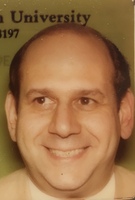 Laurence Smith, Oral History Interview, 2021
Laurence Smith, Oral History Interview, 2021 Former Vice President for Marketing and Student Affairs Laurence Smith, worked at Eastern Michigan University from 1975-2000. Smith worked in the capacity of Vice President for University Marketing and Student Affairs where he had overall leadership responsibility for strategic University marketing, communication and media relations, as well as student affairs. Smith played an important role in campus life and served on the EMU Logo Review Committee and Logo Selection Committee. In his interview, Smith describes the state of higher education thirty years ago compared to now; how alumni and community placed value in the institution vs. a symbol; and the selection process for a new logo. Smith speaks in broad strokes about higher education and their role in social justice causes and does not speak to the specifics of the committee's work.
-
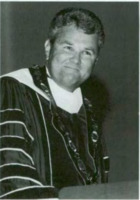 William Shelton, Oral History Interview, 2021
William Shelton, Oral History Interview, 2021 William Everett Shelton (b. 1942) was president of Eastern Michigan University 1989-2000, and is universally recognized for his work to do away with the EMU logo and mascot, seen as culturally insensitive to many inside and outside of the university. In this interview, Shelton recounts his rise to higher education administration from his roots in segregated southern schools, and the turmoil surrounding the change of the EMU logo and mascot. Arriving on the heels of the Michigan Civil Rights Commission recommendation that all Michigan schools with culturally insensitive logos and mascots make changes to those depictions, Shelton was thrust into the spotlight as a brand new university president grappling with painful institutional growing pains. This interview centers around the values espoused by Shelton in his recommendation to the Board that EMU should, in fact, change the logo and mascot, that change is inevitable, and that it was the responsibility of universities to encourage growth and change along with the rest of American culture. Shelton also wrestles with his legacy at EMU as he describes the backlash from alumni unhappy with the logo change and the longterm effects of the Board's decision to drop the Huron logo.
-
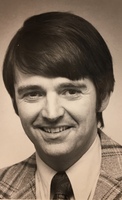 Richard Robb, Oral History Interview, 2021
Richard Robb, Oral History Interview, 2021 Longtime Ypsilanti resident and EMU Regent Dr. Richard Robb was named chair of the University Logo Committee and tasked with finding a new EMU logo to replace the Huron. Understanding that the logo was offensive to many students, Robb predicted a quick decision and adjournment. Fending off the ire of alums attached to the logo as well as the frustration and occasional apathy of fellow committee members, Robb found himself entrenched in a much larger debate over the identity of the school itself.
-
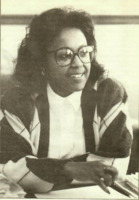 Juanita Reid, Oral History Interview, 2021
Juanita Reid, Oral History Interview, 2021 Juanita Reid served EMU for 28 years in vital roles such as Vice President of University Relations, Executive Associate to the President and Secretary of the Board of Regents. Reid's integral roles gave her a front row seat to the workings of upper administration and her view of the EMU logo and mascot change reflects this close, professional proximity. Explaining the rationale of the Board of Regents and the president in changing the mascot and logo, as well as the reactions from the community both on and off campus, Reid paints a uniquely vivid portrait of a university enmeshed in the thorny process of altering the identity of a university and committing itself to the cause of inclusivity and social justice.
-
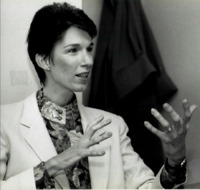 Glenna Frank Miller, Oral History Interview, 2021
Glenna Frank Miller, Oral History Interview, 2021 During her more than 40 years with Eastern Michigan University, Emerita Assistant Vice President for Student Affairs Glenna Frank Miller served in various capacities and was called a "Human Dynamo" by former Vice President for Student Affairs Laurence Smith for her tireless devotion to the student experience on campus. Serving on the EMU Logo Review Committee and Logo Selection Committee, Frank Miller describes her confidence in newly appointed EMU President William Shelton despite the public backlash from alumni for dropping the EMU Huron, a logo/mascot deemed culturally insensitive by many members of the university community. Adhering to the belief that all community members are harmed by the negative depiction of any one group, Frank Miller details the tension in Board of Regents meetings, the aftermath of the logo and mascot change, and the higher duty of academic institutions to causes of social justice.
-
 Deisha Myles, Oral History Interview, 2021
Deisha Myles, Oral History Interview, 2021 A member of the Native American Student Organization at Eastern Michigan University at the time of the struggle to change the EMU mascot and logo, Deisha [Olszewski] Myles attended nearly every meeting related to the change of what many considered to be an insensitive depiction of Native American culture. Myles speaks of her experience as a student on the Logo Selection Committee, witnessing the tense interactions between university administrators and describing the divisions amongst indigenous participants, divisions that often adhered closely to differing generational values.
-
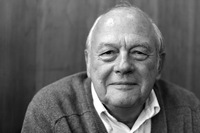 Anthony Derezinski, Oral History Interview, 2021
Anthony Derezinski, Oral History Interview, 2021 Former Michigan State Senator Anthony Derezinsky (b. 1942) joined the Eastern Michigan University Board of Regents in 1981 and served in that position until his retirement in 1996. In this interview, Derezinsky recounts his formative years with the University of Michigan Law School and Harvard Law before describing his time with the United States Navy serving with the Judge Advocate General Corps in Vietnam, 1968-1971. As a University Regent, Derezinsky played a vital role in the EMU logo/mascot change, placing the value of fairness above all other considerations. Stating that it "rankled my civil liberties heart" to see students offended by the Huron logo and mascot, and known by fellow regents as "Mr. Gavel," Derezinsky describes the process of learning from other institutions how to go about the changing of a logo/mascot that had become synonymous with school spirit and identity for many alumni and community members. Helping to steer the university through difficult ethical waters, Derezinsky traveled the country with EMU President William Shelton to provide insight to schools considering a change of logo/mascot.
-
Zimmerman, Leon
Leon Zimmerman was born in Hersey, Michigan on June 4, 1924 in a town of 206 people. Leon was attending Grand Rapids University when the Japanese bombed Pearl Harbor. He enlisted in the Army rather than being drafted and having no choice of assignment. After numerous tests, Leon was finally assigned to Bombardier training. His first six weeks were spent marching, and doing calisthenics. Eventually Leon was transferred to Las Vegas for gunnery school, followed by Advanced Bombardier School in New Mexico. Leon graduated in 2/4/44 and was sent to England by way of Baltimore and Florida, where he was assigned to a replacement crew in the 8th Air Force. Eventually, his crew was assigned to the 457th Bomb Group. His crew participated in a number of training flights before they went on a mission. Their first mission was uneventful, a "Milk Run," that experienced no flak, no losses, no battle damage. There were many other missions by his crew. Two missions especially stood out for Leon. The first was over Stettin where they took a great deal of flak and were very close to ditching the plane. They did return to England safely however. The other was in Northern Germany. His B17 crew had to bail out because of the extensive damage. After a harrowing jump, he was captured by the Home Guard. His treatment was poor until the regular army took over. Leon and his crew were assigned to a camp that was commanded by a former Luftwaffe General who treated prisoners with respect. It was not a pleasant time but certainly it was not overly difficult. Leon's camp was liberated by the Russians. After spending time in different camps and some time in Paris, he returned home, by troop ship. He met and married his wife after his discharge. They are now in retirement in Jackson, Michigan.
-
Woodside, Clifford Irvin
Clifford Woodside was born in Masten, PA. on January 22, 1923. Before completing high school, he enlisted in the Navy. This was immediately following Pearl Harbor. He was 17 at the time. Since he had been in the Sea Scouts, he was immediately assigned to training for gunnery. Clifford was eventually assigned to the USS Portland, and later to the USS Yokes. Clifford saw combat at Midway, Guadalcanal, the Solomon Islands, and the Aleutian Islands. At one time he was at sea for 110 straight days. Although he enlisted for eight years, he did not make the Navy a career. He had married by that time and elected discharge in 1947. Clifford and his wife returned to Ypsilanti, Michigan and he eventually went to work as a salesman for a local Ford dealer. Clifford and his wife lived on Ford Lake until he could no longer live independently. He and his wife now live in an assisted living facility in Ypsilanti, Michigan.
-
Woinowsk, Russell
Russell Woinowsk was born on 8/8/1915 in Debut, Iowa. His father moved to Texas when Russ was young. Russ was in the ROTC in high school and eventually joined the National Guard in order to get help with his college expenses. He was able to complete two years before entering the Army. He wanted to be a pilot but "flunked out." His training turned to Bombardier School. Russ became a trainer. He was never assigned as a permanent member of a team. When he was sent to England, he was assigned to a B24 and completed 21 missions before the end of the war. Before V-E Day Russ was returned to the United States where he began training with a B29 group. The War ended before he was able to complete any missions. When the Korean Ward started, Russell was flying with B29's and completed 16 missions. He remained in the Air Corp retiring as a Lt. Colonel. During his service he received 2 DSC's and 4 Air Metals. He spent time in Turkey, the Philippines and many different States. Upon discharge, he returned to college and eventually received a Master's Degree in teaching. He spent 21 years teaching math (20 years in Romulus High School) before retiring because he was 70, the maximum retirement age. For a time, he and two friends owned and flew a Piper Cub. He and his wife had two children. He has four grandchildren and six great grandchildren. He was married for 51 years before his wife died. He lives with his son in Ann Arbor.
 Detective John Garland A photograph of Detective John Garland, taken during the People's Lounge arrests.
Detective John Garland A photograph of Detective John Garland, taken during the People's Lounge arrests. Scenes from the 1969 March on D.C., 4 A photograph depicting scenes from the 1969 March on D.C.
Scenes from the 1969 March on D.C., 4 A photograph depicting scenes from the 1969 March on D.C. Scenes from the 1969 March on D.C., 3 A photograph depicting scenes from the 1969 March on D.C.
Scenes from the 1969 March on D.C., 3 A photograph depicting scenes from the 1969 March on D.C. Scenes from the 1969 March on D.C., 2 A photograph depicting scenes from the 1969 March on D.C.
Scenes from the 1969 March on D.C., 2 A photograph depicting scenes from the 1969 March on D.C. Scenes from the 1969 March on D.C., 1 A photograph depicting scenes from the 1969 March on D.C.
Scenes from the 1969 March on D.C., 1 A photograph depicting scenes from the 1969 March on D.C. Richard Sroges A photograph of former faculty member, Richard Sroges.
Richard Sroges A photograph of former faculty member, Richard Sroges. Tom Heisler A photograph of former English department faculty member, Tom Heisler, at a student rally.
Tom Heisler A photograph of former English department faculty member, Tom Heisler, at a student rally. Robert Zumwinkle A photograph of former administrator, Robert Zumwinkle.
Robert Zumwinkle A photograph of former administrator, Robert Zumwinkle. Ken Moon A photograph of former administrator, Ken Moon, at a student rally.
Ken Moon A photograph of former administrator, Ken Moon, at a student rally. President Harold Sponberg A photograph of former University President, Harold Sponberg.
President Harold Sponberg A photograph of former University President, Harold Sponberg. Lewis Profit at His Desk A photograph of former administrator Lewis Profit at his desk.
Lewis Profit at His Desk A photograph of former administrator Lewis Profit at his desk. Students in Front of President Sponberg's Home Photograph of students in front of President Sponberg's home.
Students in Front of President Sponberg's Home Photograph of students in front of President Sponberg's home. "Amnesty for All!" Photograph of a poster at the BSA rally.
"Amnesty for All!" Photograph of a poster at the BSA rally. "Say it Loud, I am Black and I am Proud!" Photograph of a poster at the BSA rally.
"Say it Loud, I am Black and I am Proud!" Photograph of a poster at the BSA rally. BSA Marchers, 2 Photograph of BSA marchers
BSA Marchers, 2 Photograph of BSA marchers Students Marching on Starkweather, Forest Ave. Photograph of BSA marchers in front of Starkweather Hall, on old Forest Ave.
Students Marching on Starkweather, Forest Ave. Photograph of BSA marchers in front of Starkweather Hall, on old Forest Ave. BSA Marchers with more Signs Photograph of students marching at the BSA rally.
BSA Marchers with more Signs Photograph of students marching at the BSA rally. BSA Marchers Photograph of students marching at the BSA rally.
BSA Marchers Photograph of students marching at the BSA rally. BSA Marchers with their "Amnesty" signs Photograph of students with handmade posters at the BSA rally.
BSA Marchers with their "Amnesty" signs Photograph of students with handmade posters at the BSA rally. "Free the 13 Brothers," Protest Sign Photograph of a poster at the BSA rally.
"Free the 13 Brothers," Protest Sign Photograph of a poster at the BSA rally. "Fight Racism," Protest Sign Photograph of a poster at the BSA rally.
"Fight Racism," Protest Sign Photograph of a poster at the BSA rally. BSA Rally Marchers with their Signs Photograph of a poster at the BSA rally.
BSA Rally Marchers with their Signs Photograph of a poster at the BSA rally. BSA Rally Sign, "No More Brothers in Jail" Photograph of a poster at the BSA rally.
BSA Rally Sign, "No More Brothers in Jail" Photograph of a poster at the BSA rally. Students Raise Their Fists, BSA Rally A photograph of students raising their fists in solidarity during the BSA march.
Students Raise Their Fists, BSA Rally A photograph of students raising their fists in solidarity during the BSA march. Students Gathered in Front of President Sponberg's Home A photograph of students rallying in front of the University President's house during the BSA takeover.
Students Gathered in Front of President Sponberg's Home A photograph of students rallying in front of the University President's house during the BSA takeover. "I am Black and I am Proud," Poster Photograph of a poster at the BSA rally
"I am Black and I am Proud," Poster Photograph of a poster at the BSA rally Poster at the BSA Rally Photograph of a poster at the BSA rally
Poster at the BSA Rally Photograph of a poster at the BSA rally Floyd Walton Raises a Fist A photograph of EMU student and BSA member Floyd Walton raises his fist in solidarity during the BSA takeover of Pierce Hall.
Floyd Walton Raises a Fist A photograph of EMU student and BSA member Floyd Walton raises his fist in solidarity during the BSA takeover of Pierce Hall. Police On Their Way to Pierce Hall A photograph depicting police officers on their way to Pierce Hall during the BSA takeover of 1969.
Police On Their Way to Pierce Hall A photograph depicting police officers on their way to Pierce Hall during the BSA takeover of 1969. Police Guarding Pierce Hall A photograph depicting police officers guarding the front doors of Pierce Hall during the BSA takeover of 1969.
Police Guarding Pierce Hall A photograph depicting police officers guarding the front doors of Pierce Hall during the BSA takeover of 1969. "Strike!" Shirt, 1970 A photograph depicting a student in April of 1970 wearing a handmade strike shirt.
"Strike!" Shirt, 1970 A photograph depicting a student in April of 1970 wearing a handmade strike shirt. Terry Auten, Oral History Interview, 2022 In the Fall of 2022, Matt Jones’s Oral History Techniques class conducted a set of interviews documenting the stories behind the student unrest on Eastern Michigan University’s campus from 1966-1972. Terry Auten was a student at EMU during the late 1960s and early 1970s who travelled to the National Student Conference on Vietnam, held at Cornell University and brought back to EMU his perspective on the War and increased student activism on campus.
Terry Auten, Oral History Interview, 2022 In the Fall of 2022, Matt Jones’s Oral History Techniques class conducted a set of interviews documenting the stories behind the student unrest on Eastern Michigan University’s campus from 1966-1972. Terry Auten was a student at EMU during the late 1960s and early 1970s who travelled to the National Student Conference on Vietnam, held at Cornell University and brought back to EMU his perspective on the War and increased student activism on campus. Rob Musial, Oral History Interview, 2022 In the Fall of 2022, Matt Jones’s Oral History Techniques class conducted a set of interviews documenting the stories behind the student unrest on Eastern Michigan University’s campus from 1966-1972. Rob Musial was a student at EMU during the late 1960s and early 1970s, and editor of the Eastern Echo during that time. Rob was involved with reporting on campus demonstrations and student unrest during his time there, working to make the campus aware of what was going on.
Rob Musial, Oral History Interview, 2022 In the Fall of 2022, Matt Jones’s Oral History Techniques class conducted a set of interviews documenting the stories behind the student unrest on Eastern Michigan University’s campus from 1966-1972. Rob Musial was a student at EMU during the late 1960s and early 1970s, and editor of the Eastern Echo during that time. Rob was involved with reporting on campus demonstrations and student unrest during his time there, working to make the campus aware of what was going on. Pat Fry, Oral History Interview, 2022 In the Fall of 2022, Matt Jones’s Oral History Techniques class conducted a set of interviews documenting the stories behind the student unrest on Eastern Michigan University’s campus from 1966-1972. Pat Fry was an EMU student in the late 1960s and early 1970s. She was a member of the Student Liberation Action Movement, wrote for underground newspaper The Second Coming, and Communist activist. Pat dedicated her life to fighting for equality and justice for all, continuing to be an advocate until she passed away in 2023.
Pat Fry, Oral History Interview, 2022 In the Fall of 2022, Matt Jones’s Oral History Techniques class conducted a set of interviews documenting the stories behind the student unrest on Eastern Michigan University’s campus from 1966-1972. Pat Fry was an EMU student in the late 1960s and early 1970s. She was a member of the Student Liberation Action Movement, wrote for underground newspaper The Second Coming, and Communist activist. Pat dedicated her life to fighting for equality and justice for all, continuing to be an advocate until she passed away in 2023. Ken Moon, Oral History Interview, 2022 In the Fall of 2022, Matt Jones’s Oral History Techniques class conducted a set of interviews documenting the stories behind the student unrest on Eastern Michigan University’s campus from 1966-1972. Ken Moon was a Black administrator at EMU during the lates 1960s and early 1970s, and an important mediator between the students and the administration. Moon was an influential figure on campus and supported students academically and personally.
Ken Moon, Oral History Interview, 2022 In the Fall of 2022, Matt Jones’s Oral History Techniques class conducted a set of interviews documenting the stories behind the student unrest on Eastern Michigan University’s campus from 1966-1972. Ken Moon was a Black administrator at EMU during the lates 1960s and early 1970s, and an important mediator between the students and the administration. Moon was an influential figure on campus and supported students academically and personally. John Enlund, Oral History Interview, 2022 In the Fall of 2022, Matt Jones’s Oral History Techniques class conducted a set of interviews documenting the stories behind the student unrest on Eastern Michigan University’s campus from 1966-1972. John Enlund was a dedicated student activist on EMU's campus, member of Students for a Democratic Society, and one of the students arrested at McKenny Hall on campus during the People's Lounge Incident. He was involved with others like Frank Michels and Barry Simon during this time of student unrest, and left his mark on EMU.
John Enlund, Oral History Interview, 2022 In the Fall of 2022, Matt Jones’s Oral History Techniques class conducted a set of interviews documenting the stories behind the student unrest on Eastern Michigan University’s campus from 1966-1972. John Enlund was a dedicated student activist on EMU's campus, member of Students for a Democratic Society, and one of the students arrested at McKenny Hall on campus during the People's Lounge Incident. He was involved with others like Frank Michels and Barry Simon during this time of student unrest, and left his mark on EMU. Jan Kaulins, Oral History Interview, 2022 In the Fall of 2022, Matt Jones’s Oral History Techniques class conducted a set of interviews documenting the stories behind the student unrest on Eastern Michigan University’s campus from 1966-1972. Jan Kaulins was the supreme justice on the student court at EMU during the late 1960s and early 1970s. Jan was involved with the student unrest on campus, and ruled on important cases that were brought to the court, such as the Second Coming trials. He went on to graduate school at the University of Michigan after EMU.
Jan Kaulins, Oral History Interview, 2022 In the Fall of 2022, Matt Jones’s Oral History Techniques class conducted a set of interviews documenting the stories behind the student unrest on Eastern Michigan University’s campus from 1966-1972. Jan Kaulins was the supreme justice on the student court at EMU during the late 1960s and early 1970s. Jan was involved with the student unrest on campus, and ruled on important cases that were brought to the court, such as the Second Coming trials. He went on to graduate school at the University of Michigan after EMU. Greg Fournier, Oral History Interview, 2022 In the Fall of 2022, Matt Jones’s Oral History Techniques class conducted a set of interviews documenting the stories behind the student unrest on Eastern Michigan University’s campus from 1966-1972. Greg Fournier is a current author and EMU alum who was witness to the student unrest on campus, which was happening at the same time John Norman Collins was committing his crimes. Now, Greg has written about John in his book, "Terror in Ypsilanti."
Greg Fournier, Oral History Interview, 2022 In the Fall of 2022, Matt Jones’s Oral History Techniques class conducted a set of interviews documenting the stories behind the student unrest on Eastern Michigan University’s campus from 1966-1972. Greg Fournier is a current author and EMU alum who was witness to the student unrest on campus, which was happening at the same time John Norman Collins was committing his crimes. Now, Greg has written about John in his book, "Terror in Ypsilanti." Gerald "Skip" Lawver, Oral History Interview, 2022 In the Fall of 2022, Matt Jones’s Oral History Techniques class conducted a set of interviews documenting the stories behind the student unrest on Eastern Michigan University’s campus from 1966-1972. Gerald "Skip" Lawver was an EMU student who served as an intelligence officer in the US Army, an instructor with the EMU Reserve Officers Training Corps (ROTC), a sergeant with the EMU police force. Skip was a sergeant with EMU during the events that took place near EMU's campus in May of 1970, working to keep things under control.
Gerald "Skip" Lawver, Oral History Interview, 2022 In the Fall of 2022, Matt Jones’s Oral History Techniques class conducted a set of interviews documenting the stories behind the student unrest on Eastern Michigan University’s campus from 1966-1972. Gerald "Skip" Lawver was an EMU student who served as an intelligence officer in the US Army, an instructor with the EMU Reserve Officers Training Corps (ROTC), a sergeant with the EMU police force. Skip was a sergeant with EMU during the events that took place near EMU's campus in May of 1970, working to keep things under control. Frank Michels, Oral History Interview, 2022 In the Fall of 2022, Matt Jones’s Oral History Techniques class conducted a set of interviews documenting the stories behind the student unrest on Eastern Michigan University’s campus from 1966-1972. Frank Michels was a student at EMU in the late 1960s and early 1970s. Frank was a student activist, a dedicated member of Students for a Democratic Society, and the creator of the underground newspaper, The Second Coming. He was a radical leader on campus who fought back against the administration's policies and their efforts to take his newspaper down.
Frank Michels, Oral History Interview, 2022 In the Fall of 2022, Matt Jones’s Oral History Techniques class conducted a set of interviews documenting the stories behind the student unrest on Eastern Michigan University’s campus from 1966-1972. Frank Michels was a student at EMU in the late 1960s and early 1970s. Frank was a student activist, a dedicated member of Students for a Democratic Society, and the creator of the underground newspaper, The Second Coming. He was a radical leader on campus who fought back against the administration's policies and their efforts to take his newspaper down. Ed Mattos, Oral History Interview, 2022 In the Fall of 2022, Matt Jones’s Oral History Techniques class conducted a set of interviews documenting the stories behind the student unrest on Eastern Michigan University’s campus from 1966-1972. Ed Mattos was a student at EMU in the late 1960s and early 1970s. He was a student activist, most notably as the chairman of the Student Mobilization Committee. Mattos dedicated his time at EMU to being an activist, and was involved with demonstrations on campus.
Ed Mattos, Oral History Interview, 2022 In the Fall of 2022, Matt Jones’s Oral History Techniques class conducted a set of interviews documenting the stories behind the student unrest on Eastern Michigan University’s campus from 1966-1972. Ed Mattos was a student at EMU in the late 1960s and early 1970s. He was a student activist, most notably as the chairman of the Student Mobilization Committee. Mattos dedicated his time at EMU to being an activist, and was involved with demonstrations on campus. Doug Harvey, Oral History Interview, 2022 In the Fall of 2022, Matt Jones’s Oral History Techniques class conducted a set of interviews documenting the stories behind the student unrest on Eastern Michigan University’s campus from 1966-1972. Harvey served two consecutive terms as sheriff between 1964 and 1972, and during that time he was tasked with managing the protests on EMU's campus. He was a strong individual in the Ypsilanti community, a force to be reckoned with until he passed away in 2023.
Doug Harvey, Oral History Interview, 2022 In the Fall of 2022, Matt Jones’s Oral History Techniques class conducted a set of interviews documenting the stories behind the student unrest on Eastern Michigan University’s campus from 1966-1972. Harvey served two consecutive terms as sheriff between 1964 and 1972, and during that time he was tasked with managing the protests on EMU's campus. He was a strong individual in the Ypsilanti community, a force to be reckoned with until he passed away in 2023. Dennis Hertel, Oral History Interview, 2022 In the Fall of 2022, Matt Jones’s Oral History Techniques class conducted a set of interviews documenting the stories behind the student unrest on Eastern Michigan University’s campus from 1966-1972. Dennis Hertel was an EMU student in the late 1960s and early 1970s. Vice President of the student body, and president of the student senate, Hertel was involved in making important decisions regarding the status of student unrest and upset with EMU administration. He would go on to be a United States congressman.
Dennis Hertel, Oral History Interview, 2022 In the Fall of 2022, Matt Jones’s Oral History Techniques class conducted a set of interviews documenting the stories behind the student unrest on Eastern Michigan University’s campus from 1966-1972. Dennis Hertel was an EMU student in the late 1960s and early 1970s. Vice President of the student body, and president of the student senate, Hertel was involved in making important decisions regarding the status of student unrest and upset with EMU administration. He would go on to be a United States congressman. David Cahill, Oral History Interview, 2022 In the Fall of 2022, Matt Jones’s Oral History Techniques class conducted a set of interviews documenting the stories behind the student unrest on Eastern Michigan University’s campus from 1966-1972. A former political science assistant professor at Eastern Michigan from 1969 to 1970, David Cahill was "non-rehired" after just one year for his support of students and the underground newspaper, the Second Coming. His dismissal fueled student unrest and upset with EMU administration, which led to a student led strike.
David Cahill, Oral History Interview, 2022 In the Fall of 2022, Matt Jones’s Oral History Techniques class conducted a set of interviews documenting the stories behind the student unrest on Eastern Michigan University’s campus from 1966-1972. A former political science assistant professor at Eastern Michigan from 1969 to 1970, David Cahill was "non-rehired" after just one year for his support of students and the underground newspaper, the Second Coming. His dismissal fueled student unrest and upset with EMU administration, which led to a student led strike. Dave Barsky, Oral History Interview, 2022 In the Fall of 2022, Matt Jones’s Oral History Techniques class conducted a set of interviews documenting the stories behind the student unrest on Eastern Michigan University’s campus from 1966-1972. Dave Barsky was a student at EMU in the late 1960s and early 1970s. He was a dedicated student activist, and worked closely with others like Frank Michels on the Second Coming. Barsky was represented by the American Civil Liberties Union after getting expelled from EMU, and continued to be an activist leader.
Dave Barsky, Oral History Interview, 2022 In the Fall of 2022, Matt Jones’s Oral History Techniques class conducted a set of interviews documenting the stories behind the student unrest on Eastern Michigan University’s campus from 1966-1972. Dave Barsky was a student at EMU in the late 1960s and early 1970s. He was a dedicated student activist, and worked closely with others like Frank Michels on the Second Coming. Barsky was represented by the American Civil Liberties Union after getting expelled from EMU, and continued to be an activist leader. Barry Simon, Oral History Interview, 2022 In the Fall of 2022, Matt Jones’s Oral History Techniques class conducted a set of interviews documenting the stories behind the student unrest on Eastern Michigan University’s campus from 1966-1972. Barry Simon was an EMU student in the late 1960s and early 1970s. He was a student activist involved in underground newspaper the Second Coming, and eventually arrested during the People's Lounge incident in McKenny Hall on EMU's campus. Simon would later become the student body president.
Barry Simon, Oral History Interview, 2022 In the Fall of 2022, Matt Jones’s Oral History Techniques class conducted a set of interviews documenting the stories behind the student unrest on Eastern Michigan University’s campus from 1966-1972. Barry Simon was an EMU student in the late 1960s and early 1970s. He was a student activist involved in underground newspaper the Second Coming, and eventually arrested during the People's Lounge incident in McKenny Hall on EMU's campus. Simon would later become the student body president. Anthony Head, Oral History Interview, 2022 In the Fall of 2022, Matt Jones’s Oral History Techniques class conducted a set of interviews documenting the stories behind the student unrest on Eastern Michigan University’s campus from 1966-1972. Anthony Head was a student at EMU during this time, and became involved with student activism and campus demonstrations after learning about counterculture and left-leaning politics.
Anthony Head, Oral History Interview, 2022 In the Fall of 2022, Matt Jones’s Oral History Techniques class conducted a set of interviews documenting the stories behind the student unrest on Eastern Michigan University’s campus from 1966-1972. Anthony Head was a student at EMU during this time, and became involved with student activism and campus demonstrations after learning about counterculture and left-leaning politics. Closets R4 Clothes Radio Broadcast, December 11, 1990 Closets R4 Clothes was a LGBTQ oriented student radio program from the University of Michigan's WCBN Ann Arbor. The Closets R4 Clothes collection in the Eastern Michigan University Archives contains radio broadcast recordings from 1988 to 1999. This December 1990 broadcast includes an interview with the Director Urvashi Vaid of the National Gay and Lesbian Task Force, musical selections, and a sketch comedy piece.
Closets R4 Clothes Radio Broadcast, December 11, 1990 Closets R4 Clothes was a LGBTQ oriented student radio program from the University of Michigan's WCBN Ann Arbor. The Closets R4 Clothes collection in the Eastern Michigan University Archives contains radio broadcast recordings from 1988 to 1999. This December 1990 broadcast includes an interview with the Director Urvashi Vaid of the National Gay and Lesbian Task Force, musical selections, and a sketch comedy piece. Closets R4 Clothes Radio Broadcast, October 23, 1990 Closets R4 Clothes was a LGBTQ oriented student radio program from the University of Michigan's WCBN Ann Arbor. The Closets R4 Clothes collection in the Eastern Michigan University Archives contains radio broadcast recordings from 1988 to 1999. This October 1990 broadcast includes musical selections, information on queer events in Ann Arbor and Washtenaw County, LGBTQ-related news from around the world, and an interview with American cartoonist and original creator of the Bechdel test, Alison Bechdel.
Closets R4 Clothes Radio Broadcast, October 23, 1990 Closets R4 Clothes was a LGBTQ oriented student radio program from the University of Michigan's WCBN Ann Arbor. The Closets R4 Clothes collection in the Eastern Michigan University Archives contains radio broadcast recordings from 1988 to 1999. This October 1990 broadcast includes musical selections, information on queer events in Ann Arbor and Washtenaw County, LGBTQ-related news from around the world, and an interview with American cartoonist and original creator of the Bechdel test, Alison Bechdel. Closets R4 Clothes Radio Broadcast, February 16, 1995 Closets R4 Clothes was a LGBTQ oriented student radio program from the University of Michigan's WCBN Ann Arbor. The Closets R4 Clothes collection in the Eastern Michigan University Archives contains radio broadcast recordings from 1988 to 1999. This February 1995 broadcast includes an interview with famed poet and writer Allen Ginsberg.
Closets R4 Clothes Radio Broadcast, February 16, 1995 Closets R4 Clothes was a LGBTQ oriented student radio program from the University of Michigan's WCBN Ann Arbor. The Closets R4 Clothes collection in the Eastern Michigan University Archives contains radio broadcast recordings from 1988 to 1999. This February 1995 broadcast includes an interview with famed poet and writer Allen Ginsberg. Closets R4 Clothes Radio Broadcast, August 20, 1991 Closets R4 Clothes was a LGBTQ oriented student radio program from the University of Michigan's WCBN Ann Arbor. The Closets R4 Clothes collection in the Eastern Michigan University Archives contains radio broadcast recordings from 1988 to 1999. This August 1991 broadcast includes information about queer events in Ann Arbor and Washtenaw County, musical selections, LGBTQ-related news from around the world, and an interview with an Ann Arbor area lesbian male impersonator.
Closets R4 Clothes Radio Broadcast, August 20, 1991 Closets R4 Clothes was a LGBTQ oriented student radio program from the University of Michigan's WCBN Ann Arbor. The Closets R4 Clothes collection in the Eastern Michigan University Archives contains radio broadcast recordings from 1988 to 1999. This August 1991 broadcast includes information about queer events in Ann Arbor and Washtenaw County, musical selections, LGBTQ-related news from around the world, and an interview with an Ann Arbor area lesbian male impersonator. Closets R4 Clothes Radio Broadcast, July 23, 1991 Closets R4 Clothes was a LGBTQ oriented student radio program from the University of Michigan's WCBN Ann Arbor. The Closets R4 Clothes collection in the Eastern Michigan University Archives contains radio broadcast recordings from 1988 to 1999. This July 1991 broadcast includes musical selections, information on queer events in Ann Arbor and Washtenaw County, and LGBTQ news from around the world.
Closets R4 Clothes Radio Broadcast, July 23, 1991 Closets R4 Clothes was a LGBTQ oriented student radio program from the University of Michigan's WCBN Ann Arbor. The Closets R4 Clothes collection in the Eastern Michigan University Archives contains radio broadcast recordings from 1988 to 1999. This July 1991 broadcast includes musical selections, information on queer events in Ann Arbor and Washtenaw County, and LGBTQ news from around the world. Closets R4 Clothes Radio Broadcast, July 16, 1991 Closets R4 Clothes was a LGBTQ oriented student radio program from the University of Michigan's WCBN Ann Arbor. The Closets R4 Clothes collection in the Eastern Michigan University Archives contains radio broadcast recordings from 1988 to 1999. This July 1991 broadcast includes a listing of local queer events in Ann Arbor and Washtenaw County, LGBTQ-related news from around the world, musical selections, and the second half of an interview with Native American and AIDS activist Beth Brant.
Closets R4 Clothes Radio Broadcast, July 16, 1991 Closets R4 Clothes was a LGBTQ oriented student radio program from the University of Michigan's WCBN Ann Arbor. The Closets R4 Clothes collection in the Eastern Michigan University Archives contains radio broadcast recordings from 1988 to 1999. This July 1991 broadcast includes a listing of local queer events in Ann Arbor and Washtenaw County, LGBTQ-related news from around the world, musical selections, and the second half of an interview with Native American and AIDS activist Beth Brant. Closets R4 Clothes Radio Broadcast July 07, 1991 Closets R4 Clothes was a LGBTQ oriented student radio program from the University of Michigan's WCBN Ann Arbor. The Closets R4 Clothes collection in the Eastern Michigan University Archives contains radio broadcast recordings from 1988 to 1999. This July 1991 broadcast includes information on queer related cinema, LGBTQ news from across the country, musical selections, and a piece by drag queen Vaginal Cream Davis.
Closets R4 Clothes Radio Broadcast July 07, 1991 Closets R4 Clothes was a LGBTQ oriented student radio program from the University of Michigan's WCBN Ann Arbor. The Closets R4 Clothes collection in the Eastern Michigan University Archives contains radio broadcast recordings from 1988 to 1999. This July 1991 broadcast includes information on queer related cinema, LGBTQ news from across the country, musical selections, and a piece by drag queen Vaginal Cream Davis. Closets R4 Clothes Radio Broadcast, June 04, 1991 Closets R4 Clothes was a LGBTQ oriented student radio program from the University of Michigan's WCBN Ann Arbor. The Closets R4 Clothes collection in the Eastern Michigan University Archives contains radio broadcast recordings from 1988 to 1999. This June 1991 broadcast includes an intro to the twelfth anniversary of the White Night riots in San Francisco that occurred after the assassination of Harvey Milk, musical selections, and a reading of a poem titled "I am a SCAB (Society for the Complete Annihilation of Breeding)."
Closets R4 Clothes Radio Broadcast, June 04, 1991 Closets R4 Clothes was a LGBTQ oriented student radio program from the University of Michigan's WCBN Ann Arbor. The Closets R4 Clothes collection in the Eastern Michigan University Archives contains radio broadcast recordings from 1988 to 1999. This June 1991 broadcast includes an intro to the twelfth anniversary of the White Night riots in San Francisco that occurred after the assassination of Harvey Milk, musical selections, and a reading of a poem titled "I am a SCAB (Society for the Complete Annihilation of Breeding)." Closets R4 Clothes Radio Broadcast, January 28, 1991 Closets R4 Clothes was a LGBTQ oriented student radio program from the University of Michigan's WCBN Ann Arbor. The Closets R4 Clothes collection in the Eastern Michigan University Archives contains radio broadcast recordings from 1988 to 1999. This January 1991 includes an interview with Indigo Girls singer/songwriter Amy Ray.
Closets R4 Clothes Radio Broadcast, January 28, 1991 Closets R4 Clothes was a LGBTQ oriented student radio program from the University of Michigan's WCBN Ann Arbor. The Closets R4 Clothes collection in the Eastern Michigan University Archives contains radio broadcast recordings from 1988 to 1999. This January 1991 includes an interview with Indigo Girls singer/songwriter Amy Ray. Closets R4 Clothes Radio Broadcast, January 22, 1991 Closets R4 Clothes was a LGBTQ oriented student radio program from the University of Michigan's WCBN Ann Arbor. The Closets R4 Clothes collection in the Eastern Michigan University Archives contains radio broadcast recordings from 1988 to 1999. This January 1991 broadcast includes an interview with Elise Bryant, a Ann Arbor-based playwriter of the production of "Zoo Zoo Chronicles."
Closets R4 Clothes Radio Broadcast, January 22, 1991 Closets R4 Clothes was a LGBTQ oriented student radio program from the University of Michigan's WCBN Ann Arbor. The Closets R4 Clothes collection in the Eastern Michigan University Archives contains radio broadcast recordings from 1988 to 1999. This January 1991 broadcast includes an interview with Elise Bryant, a Ann Arbor-based playwriter of the production of "Zoo Zoo Chronicles." Closets R4 Clothes Radio Broadcast, January 15, 1991 Closets R4 Clothes was a LGBTQ oriented student radio program from the University of Michigan's WCBN Ann Arbor. The Closets R4 Clothes collection in the Eastern Michigan University Archives contains radio broadcast recordings from 1988 to 1999. This January 1991 broadcast includes an interview with Ilene Lynch from the domestic violence organization SafeHouse about the topic of lesbian battery.
Closets R4 Clothes Radio Broadcast, January 15, 1991 Closets R4 Clothes was a LGBTQ oriented student radio program from the University of Michigan's WCBN Ann Arbor. The Closets R4 Clothes collection in the Eastern Michigan University Archives contains radio broadcast recordings from 1988 to 1999. This January 1991 broadcast includes an interview with Ilene Lynch from the domestic violence organization SafeHouse about the topic of lesbian battery. Closets R4 Clothes Radio Broadcasts, February 05, 1991 Closets R4 Clothes was a LGBTQ oriented student radio program from the University of Michigan's WCBN Ann Arbor. The Closets R4 Clothes collection in the Eastern Michigan University Archives contains radio broadcast recordings from 1988 to 1999. The February 1991 broadcast includes LGBTQ news and events in Washtenaw County as well as an interview with LGBTQ novelist Lev Raphael.
Closets R4 Clothes Radio Broadcasts, February 05, 1991 Closets R4 Clothes was a LGBTQ oriented student radio program from the University of Michigan's WCBN Ann Arbor. The Closets R4 Clothes collection in the Eastern Michigan University Archives contains radio broadcast recordings from 1988 to 1999. The February 1991 broadcast includes LGBTQ news and events in Washtenaw County as well as an interview with LGBTQ novelist Lev Raphael. Closets R4 Clothes Radio Broadcast, October 1990 Closets R4 Clothes was a LGBTQ oriented student radio program from the University of Michigan's WCBN Ann Arbor. The Closets R4 Clothes collection in the Eastern Michigan University Archives contains radio broadcast recordings from 1988 to 1999. This October 1990 broadcast includes an interview with novelist and gay activist Sarah Schulman.
Closets R4 Clothes Radio Broadcast, October 1990 Closets R4 Clothes was a LGBTQ oriented student radio program from the University of Michigan's WCBN Ann Arbor. The Closets R4 Clothes collection in the Eastern Michigan University Archives contains radio broadcast recordings from 1988 to 1999. This October 1990 broadcast includes an interview with novelist and gay activist Sarah Schulman. Closets R4 Clothes Radio Broadcast, September 1990 Closets R4 Clothes was a LGBTQ oriented student radio program from the University of Michigan's WCBN Ann Arbor. The Closets R4 Clothes collection in the Eastern Michigan University Archives contains radio broadcast recordings from 1988 to 1999. This September 1990 broadcast includes musical selections and an in-depth interview with three members of the HIV/AIDS advocacy group ACT UP Ann Arbor and a defendant in the Adrian 17 sex scandal in Adrian, Michigan. The Adrian 17 were seventeen male defendants who were all charged with gross indecency for engaging in homosexual acts at a public park. Over half of the men were over 40, married, and had children living in the Adrian community. The local Adrian newspaper published the names and addresses of each defendant on the front page of the newspaper.
Closets R4 Clothes Radio Broadcast, September 1990 Closets R4 Clothes was a LGBTQ oriented student radio program from the University of Michigan's WCBN Ann Arbor. The Closets R4 Clothes collection in the Eastern Michigan University Archives contains radio broadcast recordings from 1988 to 1999. This September 1990 broadcast includes musical selections and an in-depth interview with three members of the HIV/AIDS advocacy group ACT UP Ann Arbor and a defendant in the Adrian 17 sex scandal in Adrian, Michigan. The Adrian 17 were seventeen male defendants who were all charged with gross indecency for engaging in homosexual acts at a public park. Over half of the men were over 40, married, and had children living in the Adrian community. The local Adrian newspaper published the names and addresses of each defendant on the front page of the newspaper. Closets R4 Clothes Radio Broadcast, May 08, 1990 Closets R4 Clothes was a LGBTQ oriented student radio program from the University of Michigan's WCBN Ann Arbor. The Closets R4 Clothes collection in the Eastern Michigan University Archives contains radio broadcast recordings from 1988 to 1999. This May 1990 broadcast includes musical selections and a detailed discussion with a University of Michigan PhD candidate Raelynn Hillhouse, who studied extensively in Communist East German and in Soviet influenced Eastern Europe. The conversation with Hillhouse describes the status of LGBTQ people living and expressing themselves in Eastern Bloc countries.
Closets R4 Clothes Radio Broadcast, May 08, 1990 Closets R4 Clothes was a LGBTQ oriented student radio program from the University of Michigan's WCBN Ann Arbor. The Closets R4 Clothes collection in the Eastern Michigan University Archives contains radio broadcast recordings from 1988 to 1999. This May 1990 broadcast includes musical selections and a detailed discussion with a University of Michigan PhD candidate Raelynn Hillhouse, who studied extensively in Communist East German and in Soviet influenced Eastern Europe. The conversation with Hillhouse describes the status of LGBTQ people living and expressing themselves in Eastern Bloc countries. Closets R4 Clothes Radio Broadcast, May 01, 1990 Closets R4 Clothes was a LGBTQ oriented student radio program from the University of Michigan's WCBN Ann Arbor. The Closets R4 Clothes collection in the Eastern Michigan University Archives contains radio broadcast recordings from 1988 to 1999. This May 1990 broadcast includes musical selections, news and announcements on LGBTQ related events and information, and an interview with three guests from the University of Michigan and ACT UP to discuss the status of HIV/AIDS in the country.
Closets R4 Clothes Radio Broadcast, May 01, 1990 Closets R4 Clothes was a LGBTQ oriented student radio program from the University of Michigan's WCBN Ann Arbor. The Closets R4 Clothes collection in the Eastern Michigan University Archives contains radio broadcast recordings from 1988 to 1999. This May 1990 broadcast includes musical selections, news and announcements on LGBTQ related events and information, and an interview with three guests from the University of Michigan and ACT UP to discuss the status of HIV/AIDS in the country. Closets R4 Clothes Radio Broadcasts, January 30, 1990 Closets R4 Clothes was a LGBTQ oriented student radio program from the University of Michigan's WCBN Ann Arbor. The Closets R4 Clothes collection in the Eastern Michigan University Archives contains radio broadcast recordings from 1988 to 1999. The January broadcast highlights LGBTQ news and events in Ann Arbor and the University of Michigan and includes the reading of a queer poem. The February broadcast begins with news and announcements about LGBTQ events and information in Washtenaw County, and later includes a roundtable discussion from several people about being the child of lesbian or gay parents.
Closets R4 Clothes Radio Broadcasts, January 30, 1990 Closets R4 Clothes was a LGBTQ oriented student radio program from the University of Michigan's WCBN Ann Arbor. The Closets R4 Clothes collection in the Eastern Michigan University Archives contains radio broadcast recordings from 1988 to 1999. The January broadcast highlights LGBTQ news and events in Ann Arbor and the University of Michigan and includes the reading of a queer poem. The February broadcast begins with news and announcements about LGBTQ events and information in Washtenaw County, and later includes a roundtable discussion from several people about being the child of lesbian or gay parents. Closets R4 Clothes Radio Broadcast, June 25, 1991 Closets R4 Clothes was a LGBTQ oriented student radio program from the University of Michigan's WCBN Ann Arbor. The Closets R4 Clothes collection in the Eastern Michigan University Archives contains radio broadcast recordings from 1988 to 1999. This broadcast from June 1991 includes an update on queer news and events in Ann Arbor and Washtenaw County and an interview with Matt Bower from the local Metro Detroit chapter of Copwatch.
Closets R4 Clothes Radio Broadcast, June 25, 1991 Closets R4 Clothes was a LGBTQ oriented student radio program from the University of Michigan's WCBN Ann Arbor. The Closets R4 Clothes collection in the Eastern Michigan University Archives contains radio broadcast recordings from 1988 to 1999. This broadcast from June 1991 includes an update on queer news and events in Ann Arbor and Washtenaw County and an interview with Matt Bower from the local Metro Detroit chapter of Copwatch. Laurence Smith, Oral History Interview, 2021 Former Vice President for Marketing and Student Affairs Laurence Smith, worked at Eastern Michigan University from 1975-2000. Smith worked in the capacity of Vice President for University Marketing and Student Affairs where he had overall leadership responsibility for strategic University marketing, communication and media relations, as well as student affairs. Smith played an important role in campus life and served on the EMU Logo Review Committee and Logo Selection Committee. In his interview, Smith describes the state of higher education thirty years ago compared to now; how alumni and community placed value in the institution vs. a symbol; and the selection process for a new logo. Smith speaks in broad strokes about higher education and their role in social justice causes and does not speak to the specifics of the committee's work.
Laurence Smith, Oral History Interview, 2021 Former Vice President for Marketing and Student Affairs Laurence Smith, worked at Eastern Michigan University from 1975-2000. Smith worked in the capacity of Vice President for University Marketing and Student Affairs where he had overall leadership responsibility for strategic University marketing, communication and media relations, as well as student affairs. Smith played an important role in campus life and served on the EMU Logo Review Committee and Logo Selection Committee. In his interview, Smith describes the state of higher education thirty years ago compared to now; how alumni and community placed value in the institution vs. a symbol; and the selection process for a new logo. Smith speaks in broad strokes about higher education and their role in social justice causes and does not speak to the specifics of the committee's work. William Shelton, Oral History Interview, 2021 William Everett Shelton (b. 1942) was president of Eastern Michigan University 1989-2000, and is universally recognized for his work to do away with the EMU logo and mascot, seen as culturally insensitive to many inside and outside of the university. In this interview, Shelton recounts his rise to higher education administration from his roots in segregated southern schools, and the turmoil surrounding the change of the EMU logo and mascot. Arriving on the heels of the Michigan Civil Rights Commission recommendation that all Michigan schools with culturally insensitive logos and mascots make changes to those depictions, Shelton was thrust into the spotlight as a brand new university president grappling with painful institutional growing pains. This interview centers around the values espoused by Shelton in his recommendation to the Board that EMU should, in fact, change the logo and mascot, that change is inevitable, and that it was the responsibility of universities to encourage growth and change along with the rest of American culture. Shelton also wrestles with his legacy at EMU as he describes the backlash from alumni unhappy with the logo change and the longterm effects of the Board's decision to drop the Huron logo.
William Shelton, Oral History Interview, 2021 William Everett Shelton (b. 1942) was president of Eastern Michigan University 1989-2000, and is universally recognized for his work to do away with the EMU logo and mascot, seen as culturally insensitive to many inside and outside of the university. In this interview, Shelton recounts his rise to higher education administration from his roots in segregated southern schools, and the turmoil surrounding the change of the EMU logo and mascot. Arriving on the heels of the Michigan Civil Rights Commission recommendation that all Michigan schools with culturally insensitive logos and mascots make changes to those depictions, Shelton was thrust into the spotlight as a brand new university president grappling with painful institutional growing pains. This interview centers around the values espoused by Shelton in his recommendation to the Board that EMU should, in fact, change the logo and mascot, that change is inevitable, and that it was the responsibility of universities to encourage growth and change along with the rest of American culture. Shelton also wrestles with his legacy at EMU as he describes the backlash from alumni unhappy with the logo change and the longterm effects of the Board's decision to drop the Huron logo. Richard Robb, Oral History Interview, 2021 Longtime Ypsilanti resident and EMU Regent Dr. Richard Robb was named chair of the University Logo Committee and tasked with finding a new EMU logo to replace the Huron. Understanding that the logo was offensive to many students, Robb predicted a quick decision and adjournment. Fending off the ire of alums attached to the logo as well as the frustration and occasional apathy of fellow committee members, Robb found himself entrenched in a much larger debate over the identity of the school itself.
Richard Robb, Oral History Interview, 2021 Longtime Ypsilanti resident and EMU Regent Dr. Richard Robb was named chair of the University Logo Committee and tasked with finding a new EMU logo to replace the Huron. Understanding that the logo was offensive to many students, Robb predicted a quick decision and adjournment. Fending off the ire of alums attached to the logo as well as the frustration and occasional apathy of fellow committee members, Robb found himself entrenched in a much larger debate over the identity of the school itself. Juanita Reid, Oral History Interview, 2021 Juanita Reid served EMU for 28 years in vital roles such as Vice President of University Relations, Executive Associate to the President and Secretary of the Board of Regents. Reid's integral roles gave her a front row seat to the workings of upper administration and her view of the EMU logo and mascot change reflects this close, professional proximity. Explaining the rationale of the Board of Regents and the president in changing the mascot and logo, as well as the reactions from the community both on and off campus, Reid paints a uniquely vivid portrait of a university enmeshed in the thorny process of altering the identity of a university and committing itself to the cause of inclusivity and social justice.
Juanita Reid, Oral History Interview, 2021 Juanita Reid served EMU for 28 years in vital roles such as Vice President of University Relations, Executive Associate to the President and Secretary of the Board of Regents. Reid's integral roles gave her a front row seat to the workings of upper administration and her view of the EMU logo and mascot change reflects this close, professional proximity. Explaining the rationale of the Board of Regents and the president in changing the mascot and logo, as well as the reactions from the community both on and off campus, Reid paints a uniquely vivid portrait of a university enmeshed in the thorny process of altering the identity of a university and committing itself to the cause of inclusivity and social justice. Glenna Frank Miller, Oral History Interview, 2021 During her more than 40 years with Eastern Michigan University, Emerita Assistant Vice President for Student Affairs Glenna Frank Miller served in various capacities and was called a "Human Dynamo" by former Vice President for Student Affairs Laurence Smith for her tireless devotion to the student experience on campus. Serving on the EMU Logo Review Committee and Logo Selection Committee, Frank Miller describes her confidence in newly appointed EMU President William Shelton despite the public backlash from alumni for dropping the EMU Huron, a logo/mascot deemed culturally insensitive by many members of the university community. Adhering to the belief that all community members are harmed by the negative depiction of any one group, Frank Miller details the tension in Board of Regents meetings, the aftermath of the logo and mascot change, and the higher duty of academic institutions to causes of social justice.
Glenna Frank Miller, Oral History Interview, 2021 During her more than 40 years with Eastern Michigan University, Emerita Assistant Vice President for Student Affairs Glenna Frank Miller served in various capacities and was called a "Human Dynamo" by former Vice President for Student Affairs Laurence Smith for her tireless devotion to the student experience on campus. Serving on the EMU Logo Review Committee and Logo Selection Committee, Frank Miller describes her confidence in newly appointed EMU President William Shelton despite the public backlash from alumni for dropping the EMU Huron, a logo/mascot deemed culturally insensitive by many members of the university community. Adhering to the belief that all community members are harmed by the negative depiction of any one group, Frank Miller details the tension in Board of Regents meetings, the aftermath of the logo and mascot change, and the higher duty of academic institutions to causes of social justice. Deisha Myles, Oral History Interview, 2021 A member of the Native American Student Organization at Eastern Michigan University at the time of the struggle to change the EMU mascot and logo, Deisha [Olszewski] Myles attended nearly every meeting related to the change of what many considered to be an insensitive depiction of Native American culture. Myles speaks of her experience as a student on the Logo Selection Committee, witnessing the tense interactions between university administrators and describing the divisions amongst indigenous participants, divisions that often adhered closely to differing generational values.
Deisha Myles, Oral History Interview, 2021 A member of the Native American Student Organization at Eastern Michigan University at the time of the struggle to change the EMU mascot and logo, Deisha [Olszewski] Myles attended nearly every meeting related to the change of what many considered to be an insensitive depiction of Native American culture. Myles speaks of her experience as a student on the Logo Selection Committee, witnessing the tense interactions between university administrators and describing the divisions amongst indigenous participants, divisions that often adhered closely to differing generational values. Anthony Derezinski, Oral History Interview, 2021 Former Michigan State Senator Anthony Derezinsky (b. 1942) joined the Eastern Michigan University Board of Regents in 1981 and served in that position until his retirement in 1996. In this interview, Derezinsky recounts his formative years with the University of Michigan Law School and Harvard Law before describing his time with the United States Navy serving with the Judge Advocate General Corps in Vietnam, 1968-1971. As a University Regent, Derezinsky played a vital role in the EMU logo/mascot change, placing the value of fairness above all other considerations. Stating that it "rankled my civil liberties heart" to see students offended by the Huron logo and mascot, and known by fellow regents as "Mr. Gavel," Derezinsky describes the process of learning from other institutions how to go about the changing of a logo/mascot that had become synonymous with school spirit and identity for many alumni and community members. Helping to steer the university through difficult ethical waters, Derezinsky traveled the country with EMU President William Shelton to provide insight to schools considering a change of logo/mascot.
Anthony Derezinski, Oral History Interview, 2021 Former Michigan State Senator Anthony Derezinsky (b. 1942) joined the Eastern Michigan University Board of Regents in 1981 and served in that position until his retirement in 1996. In this interview, Derezinsky recounts his formative years with the University of Michigan Law School and Harvard Law before describing his time with the United States Navy serving with the Judge Advocate General Corps in Vietnam, 1968-1971. As a University Regent, Derezinsky played a vital role in the EMU logo/mascot change, placing the value of fairness above all other considerations. Stating that it "rankled my civil liberties heart" to see students offended by the Huron logo and mascot, and known by fellow regents as "Mr. Gavel," Derezinsky describes the process of learning from other institutions how to go about the changing of a logo/mascot that had become synonymous with school spirit and identity for many alumni and community members. Helping to steer the university through difficult ethical waters, Derezinsky traveled the country with EMU President William Shelton to provide insight to schools considering a change of logo/mascot.